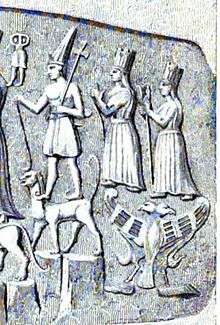Šarruma
Šarruma or Sharruma was a Hurrian mountain god, who was also worshipped by the Hittites and Luwians.
| Sarruma | |
|---|---|
King of the mountains | |
 Šarruma (at left) standing on the back of a panther | |
| Personal information | |
| Parents | Teshub, the weather-god Goddess Hebat |
| Siblings | Inara |
| Consort | Daughter of Illuyanka |

Name
The original source and meaning of the name is unknown. In Hittite and Hurrian texts, his name was linked with the Akkadian šarri ("King") and could be written with the Sumerogram for King, LUGAL-ma. In Hieroglyphic Luwian, his name was written with a pair of walking legs, which is transcribed as SARMA.
Description
Šarruma is a son of the weather-god Teshub and the goddess Ḫepat and brother of the goddess Inara. He is often depicted riding a tiger or panther and carrying an axe (cf. labrys). He is depicted behind his father on the Illuyanka's relief found in Malatya (dating 1050-850 BC), on display in the Museum of Anatolian Civilizations in Ankara, Turkey. His wife is the daughter of the dragon Illuyanka.[1]
Development
Šarruma was originally a bull-shaped mountain god of the Anatolian borderlands. Early research suggested that Šarruma was originally the partner of the goddess Ḫepat and had subsequently been replaced by Teššup and demoted to be the goddess' son.[2] Newer research indicates that Ḫepat was always the partner of the weather god of Aleppo and that early depictions of Ḫepat and Šarruma as a pair understood them as mother and son.[3]
Hittites
There was a prince named after him: Ašmi-Šarruma, son of king Arnuwanda I.[4] After the Hittite king Šuppiluliuma I installed his son Telipinu as Priest of Aleppo, the cult of Šarruma was adopted and became popular among the Hittites. King Tudḫaliya IV chose him as his personal guardian god, while his father's wife Puduḫepa had a dream in which she vowed to build twelve shrines for him in the mountains.[5] The seal of Mursili III as crown prince depicted him being embraced by Šarruma.[6] In the procession of the Hittite gods at Yazılıkaya, he stands behind his mother on a leopard and is depicted in chamber B as Tudḫaliya's protector. On the Hanyeri relief he is depicted in the form of a bull.[7][8] As the double god Šarrumanni, Šarruma was invoked as an intermediary and protector.[9]
Luwians
In the Iron Age, Šarruma continued to be worshipped in Syria and Southern Anatolia. The king of Tabal, Wasusarma, who is attested in the Hieroglyphic Luwian inscription of the Topada relief was named after him and records him in second place in his list of the gods, immediately behind the weather god Tarhunza.[10]
See also
- Hittite mythology
- Hurrian mythology
References
- Porzig, W. "Illuyankas und Typhon", Kleinasiatische Forschung I.3 (1930) pp379–86.
- e.g. Volkert Haas: Geschichte der hethitischen Religion. Brill 1994, ISBN 90-04-09799-6.
- Marie-Claude Trémouille, "dḪebat. Une divinité syro-anatolienne." In: Eothen. 7, 1997, pp. 189f.
- Arnuwanda I Archived 2013-07-29 at the Wayback Machine
- Volkert Haas: Handbuch der Orientalistik. Brill, 1994, ISBN 90-04-09799-6, p. 390.
- Piotr Taracha: Religions of Second Millennium Anatolia. Wiesbaden 2009, p. 91.
- Kay Kohlmeyer: "Felsbilder der hethitischen Großreichszeit." Acta Praehistorica et Archaeologica. 15, 1983, p. 90.
- Horst Ehringhaus: Götter, Herrscher, Inschriften. Die Felsreliefs der hethitischen Großreichszeit in der Türkei. Zabern, Mainz 2005, ISBN 3-8053-3469-9, p. 78.
- Volkert Haas, Heidemarie Koch: Religionen des alten Orients: Hethiter und Iran. Göttingen 2011, p. 241.
- Annick Payne: Iron Age Hieroglyphic Luwian Inscriptions. Atlanta 2012, p. 54–59.
Further reading
- Laroche E. "Le dieu anatolien Sarrumma". In: Syria. Tome 40 fascicule 3-4, 1963. pp. 277-302. [DOI: https://doi.org/10.3406/syria.1963.8468] ; www.persee.fr/doc/syria_0039-7946_1963_num_40_3_8468